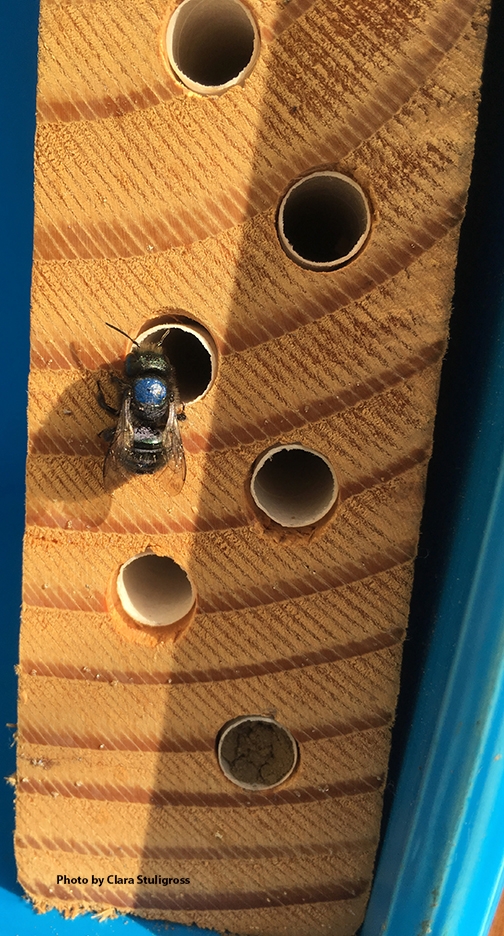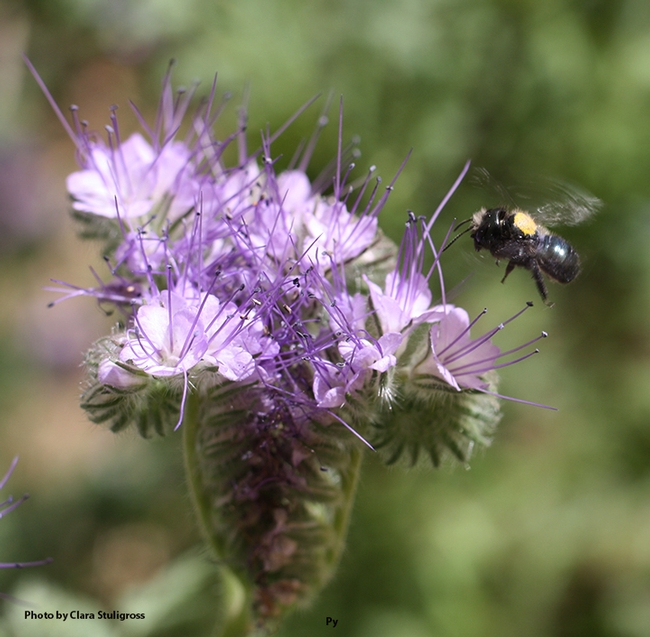
Lead author Clara Stuligross, a doctoral student in the lab of pollination ecologist Neal Williams, a professor in the Department of Entomology and Nematology, teamed with Williams to study the results of food scarcity and pesticide exposure.
They exposed the bees to the neonicotinoid insecticide imidacloprid, widely used in agriculture, and found that the combined threats—imidacloprid exposure and the loss of flowering plants—reduced the bee's reproduction by 57 percent, resulting in fewer female offspring.
Of the two stressors—food scarcity and pesticide exposure—pesticide exposure showed the great impact on nesting activity and the number of offspring produced, they said.
The study, Pesticide and Resource Stressors Additively Impair Wild Bee Reproduction, accomplished in the spring of 2018 on the grounds of the UC Davis Harry H. Laidlaw Jr. Facility, is published in the journal Proceedings of the Royal Society B.
Other scientists have conducted similar research on honey bees, but this is the first comparable research on wild bees in field or semi-field conditions.
The blue orchard bee, nicknamed BOB, is a dark metallic mason bee, smaller than a honey bee. It is prized for pollinating almond, apple, plum, pear, and peach trees. California almond growers often set up bee boxes or bee condos for them in their orchards to aid in the honey bee pollination. In the wild, the bees nest in reeds or natural holes.

To study the survival, nesting and reproduction of the blue orchard bee, they set up nesting females in large flight cages, some with high densities of wildflowers and others with low densities that were treated “with or without the common insecticide, imidacloprid.” Bees are commonly exposed to insecticides when they forage on treated flowers.

"Understanding how multiple stressors interplay is really important, especially for bee populations in agricultural systems, where wild bees are commonly exposed to pesticides and food can be scarce,” said Stuligross, who holds a bachelor of arts degree in environmental studies (2014) from Earlham College, Richmond, Ind. She joined the UC Davis ecology doctoral program in 2016.
Onset of Nesting Delayed
Key factors in affecting bee reproduction are the probability that females will nest and the total number of offspring they have. The UC Davis research found that pesticide-exposed and resource-deprived female bees delayed the onset of nesting by 3.6 days and spent five fewer days nesting than unexposed bees.
Professor Williams pointed out that this is a substantial delay because bees nest only for a few weeks, and it's crucial to reproduce female offspring to carry on the future generations. “Fewer females will reduce the reproductive potential of subsequent generations," said Williams, a UC Davis Chancellor's Fellow and a newly elected fellow of the California Academy of Sciences.
They found that only 62 percent of pesticide-exposed bees produced at least one daughter compared to 92 percent of bees not exposed to pesticides.
The study drew support from a UC Davis Jastro Research Award, a UC Davis Ecology Graduate Research Fellowship, a National Science Foundation Graduate Research Fellowship, and the UC Davis bee biology facility
The blue orchard bee bee is one of the few native pollinators that is managed in agriculture. North America has 140 species of Osmia, according to a Pollinator Partnership (PP) article in a U. S. Forest Service publication, authored by entomologist and PP member Beatriz Moisset and PP director Vicki Wojcik. “Mason bees use clay to make partitions and to seal the entrance,” they wrote. “This unique mud-building behavior leads to their common designation as mason bees. Honey bees are very important to commercial agriculture, but native bees like the blue orchard bees are better and more efficient pollinators of native crops.”
Imidacloprid, a systemic insecticide that acts as an insect neurotoxin, is used to control sucking insects, termites, some soil insects and fleas on pets, according to National Pesticide Information Center. It mimics nicotine, toxic to insects, which is naturally found in many plants, including tobacco. More than 400 products for sale in the United States contain imidacloprid.
Attached Images:
